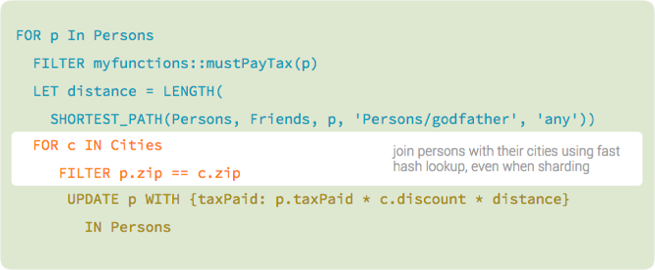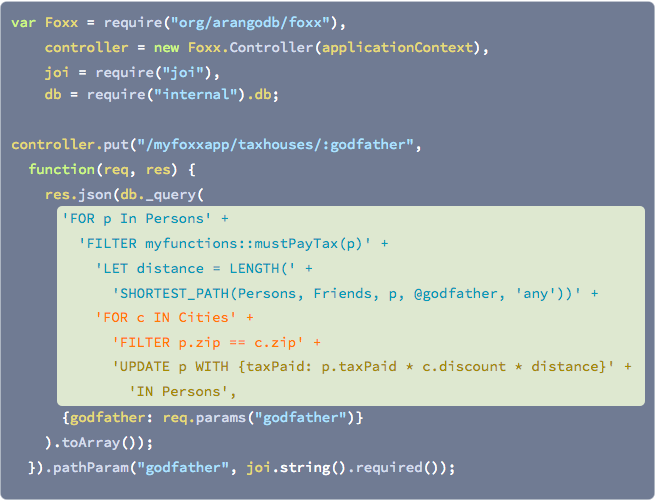|
|
||
|---|---|---|
| .hooks | ||
| 3rdParty | ||
| Documentation | ||
| Installation | ||
| UnitTests | ||
| arangod | ||
| arangosh | ||
| config | ||
| etc | ||
| js | ||
| lib | ||
| m4 | ||
| scripts | ||
| utils | ||
| .gitignore | ||
| .travis.yml | ||
| CHANGELOG | ||
| CMakeLists.txt | ||
| CONTRIBUTING.md | ||
| DEPRECATED.md | ||
| EXPERIMENTAL | ||
| GNUmakefile | ||
| LICENSE | ||
| LICENSES-OTHER-COMPONENTS.md | ||
| Makefile.am | ||
| README | ||
| README.md | ||
| README.windows | ||
| README_maintainers.md | ||
| VERSION | ||
| build.h | ||
| configure.ac | ||
README.md
ArangoDB
ArangoDB is a multi-model, open-source database with flexible data models for documents, graphs, and key-values. Build high performance applications using a convenient SQL-like query language or JavaScript extensions. Use ACID transactions if you require them. Scale horizontally with a few mouse clicks.
The supported data models can be mixed in queries and allow ArangoDB to be the aggregation point for your data.
To get started, try one of our 10 minutes tutorials in your favourite programming language or try one of our ArangoDB Cookbook recipes.
For the impatient: download and install ArangoDB. Start the server arangod and point your browser to http://127.0.0.1:8529/.
Key Features in ArangoDB
- Multi-Model: Documents, graphs and key-value pairs — model your data as you see fit for your application.
- Joins: Conveniently join what belongs together for flexible ad-hoc querying, less data redundancy.
- Transactions: Easy application development keeping your data consistent and safe. No hassle in your client.
Here is an AQL query that makes use of all those features:
Joins and transactions are key features for flexible, secure data designs, widely used in relational databases but lacking in many NoSQL products. However, there is no need to forego them in ArangoDB. You decide how and when to use joins and strong consistency guarantees, without sacrificing performance and scalability.
Furthermore, ArangoDB offers a JavaScript framework called Foxx that is executed in the database server with direct access to the data. Build your own data-centric microservices with a few lines of code:
Microservice Example
By extending the HTTP API with user code written in JavaScript, ArangoDB can be turned into a strict schema-enforcing persistence engine.
Next step, bundle your Foxx application as a docker container and get it running in the cloud.
Other features of ArangoDB include:
- Schema-free schemata let you combine the space efficiency of MySQL with the performance power of NoSQL
- Use a data-centric microservices approach with ArangoDB Foxx and fuse your application-logic and database together for maximal throughput
- JavaScript for all: no language zoo, you can use one language from your browser to your back-end
- ArangoDB is multi-threaded - exploit the power of all your cores
- Flexible data modelling: model your data as combination of key-value pairs, documents or graphs - perfect for social relations
- Free index choice: use the correct index for your problem, be it a skip list or a fulltext search
- Configurable durability: let the application decide if it needs more durability or more performance
- Powerful query language (AQL) to retrieve and modify data
- Transactions: run queries on multiple documents or collections with optional transactional consistency and isolation
- Replication and Sharding: set up the database in a master-slave configuration or spread bigger datasets across multiple servers
- It is open source (Apache Licence 2.0)
For more in-depth information read the design goals of ArangoDB
Latest Release - ArangoDB 2.5
The full changelog can be found in the documentation.
Sparse Indexes: In ArangoDB 2.5, hash and skiplist indexes can optionally be made sparse. Here is a performance comparison that shows how you can benefit from great savings in memory and index creation CPU time declaring indexes as sparse.
We’ve added some small but useful AQL language improvements plus several AQL optimizer improvements.
Object attribute names in ArangoDB 2.5 can be specified using static string literals, bind parameters, and dynamic expressions.
Function RANDOM_TOKEN(length): produces a pseudo-random string of the specified length. Such strings can be used for id or token generation.
One example implementation is the API-Key management that restricts access to certain routes of an API. You can use this custom Foxx library to start charging your valuable data right away.
Streamlined development process: ArangoDB 2.5 improves the development process of data-centric microservices with the Foxx framework.
Installing an app is now as easy as it should be:
- install: get your Foxx app up and running
- uninstall: shut it down and erase it from disk
Developers can enable the new development mode per app. The development mode makes app code changes live instantly, without the need to re-deploy. Additionally, it provides fine-grained debugging information.
More Information
Please check the Installation Manual for installation and compilation instructions.
The User Manual has an introductory chapter showing the basic operations of ArangoDB.
Stay in Contact
We really appreciate feature requests and bug reports. Please use our Github issue tracker for reporting them:
https://github.com/arangodb/arangodb/issues
You can use the Google group for improvements, feature requests, comments







